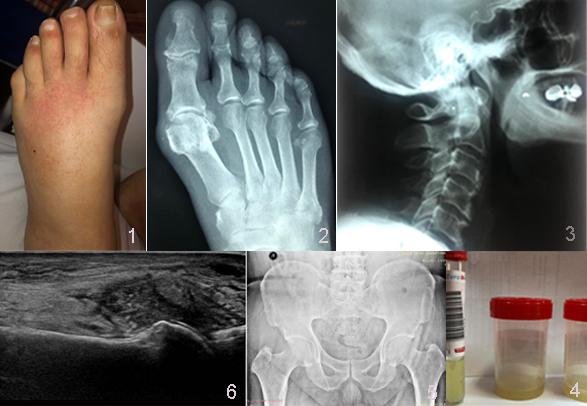Solving a Rheumatology puzzle
Polypathology rheumatic enigma
Image Description
The association of microcrystalline arthropathy with other arthritides is not a common occurrence in clinical practice, thus classifying joint involvement can be a challenge for rheumatologists(1).
We present a case of a 66-year-old male patient, with a history of hypertension, diabetes, dyslipidemia, and known ankylosing spondylitis (AS) without background treatment presented for painful swelling of the knees and ankles. Recent investigations revealed an E.coli urinary tract infection for which he received antibiotics. Upon admission, the patient was afebrile, had an intense inflammatory syndrome, high levels of uric acid. The purulent appearance of the joint fluid required prompt initiation of antibiotic therapy, despite subsequent negative cultures.
Plain X-rays confirmed AS with symmetrical stage 4 sacroiliitis, multiple-site enthesopathy, typical syndesmophytes of thoracic bodies, Anderssonian lesions but also a suggestive aspect for Forestier’s disease with large complete bony bridges at the cervical and lumbar vertebral bodies.
The forefoot imaging showed a periarticular opacity of the first metatarsophalangeal joint, indicating a tophus-like lesion as well as classical "overhanging edges" erosions. Ultrasound changes were consistent with the diagnosis of gout. Surprisingly, the crystallographic examination established the presence of birefringent polyhedral microcrystals in polarized light, indicative of pseudogout. The patient also associated osteoarthritis changes.
This is the case of a dysmetabolic patient with old AS overlapping chronic gout who developed septic arthritis with a urinary starting point. He suffered an acute polyarticular microcrystalline attack.
Differentiating causes of arthritis in a patient with associated rheumatological polypathology can be difficult, despite available clinical and paraclinical investigations.
References
Gonen T, Tiosano S, Comaneshter D, Amital H, Cohen AD, Shovman O. The coexistence of gout in ankylosing spondylitis patients: a case control study. Rheumatol Int 2019 403. 2019 Oct 19;40(3):465–70.


